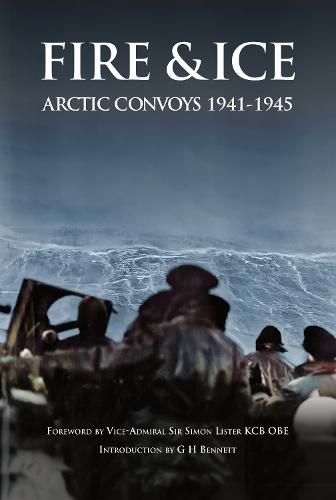Readings Newsletter
Become a Readings Member to make your shopping experience even easier.
Sign in or sign up for free!
You’re not far away from qualifying for FREE standard shipping within Australia
You’ve qualified for FREE standard shipping within Australia
The cart is loading…






This title is printed to order. This book may have been self-published. If so, we cannot guarantee the quality of the content. In the main most books will have gone through the editing process however some may not. We therefore suggest that you be aware of this before ordering this book. If in doubt check either the author or publisher’s details as we are unable to accept any returns unless they are faulty. Please contact us if you have any questions.
The Arctic convoys run to the ports of Northern Russia from 1941 to 1945 combined the man-made and maritime horrors of the Battle of the Atlantic with the unforgiving ferocity of one of the most inhospitable of the world's climates. Maintaining that lifeline through the waters of the Arctic circle was essential to the development and maintenance of the Anglo-American alliance with the Soviet Union. With the massive campaign on Germany's Eastern front hanging in the balance in 1941 to 1942, the German Armed Forces deployed significant numbers of submarines, bomber and torpedo aircraft, together with heavy ships such as the Tirpitz and Scharnhorst, against the slow-moving Allied convoys of merchant ships and their escorting forces. The challenge to maintain this lifeline placed a heavy burden on the resources of the Royal Navy. Here, in a contemporary battle summary, prepared by the Naval Staff of the Royal Navy, and supported by academic analysis and an extensive photographic section, those challenges and difficulties, the tragedies and the triumphs of the Arctic convoys, are laid bare. A Shared Strategic Goal. The Arctic Convoys reflect the need to be able to work with enemies who become allies, and vice versa, and understand the strategic circumstances and imperatives that drive those choices. This strategic perspective and agility characterised Churchill's approach to Stalin and the Soviet Union. It is notable that British co-operation with the Soviet Union started before the US had entered the war, and continued to the end, reflecting British strategic national interests throughout. The intent and comradeship forged through the existence of a common foe survived the many operational set-backs and doubts on both sides, and speaks clearly to the need in these matters to have a clear, shared strategic goal and enduring commitment to its achievement. Leadership of Effective Collaboration. The collaboration and integration at a working level that was achieved in a short space of time was remarkable, given the suspicion and gulf of political outlook that existed at the outset. Genuine collaboration and integration delivered a whole that was greater than the sum of its parts. what Churchill is credited with calling 'the worst journey in the world.'
$9.00 standard shipping within Australia
FREE standard shipping within Australia for orders over $100.00
Express & International shipping calculated at checkout
Stock availability can be subject to change without notice. We recommend calling the shop or contacting our online team to check availability of low stock items. Please see our Shopping Online page for more details.
This title is printed to order. This book may have been self-published. If so, we cannot guarantee the quality of the content. In the main most books will have gone through the editing process however some may not. We therefore suggest that you be aware of this before ordering this book. If in doubt check either the author or publisher’s details as we are unable to accept any returns unless they are faulty. Please contact us if you have any questions.
The Arctic convoys run to the ports of Northern Russia from 1941 to 1945 combined the man-made and maritime horrors of the Battle of the Atlantic with the unforgiving ferocity of one of the most inhospitable of the world's climates. Maintaining that lifeline through the waters of the Arctic circle was essential to the development and maintenance of the Anglo-American alliance with the Soviet Union. With the massive campaign on Germany's Eastern front hanging in the balance in 1941 to 1942, the German Armed Forces deployed significant numbers of submarines, bomber and torpedo aircraft, together with heavy ships such as the Tirpitz and Scharnhorst, against the slow-moving Allied convoys of merchant ships and their escorting forces. The challenge to maintain this lifeline placed a heavy burden on the resources of the Royal Navy. Here, in a contemporary battle summary, prepared by the Naval Staff of the Royal Navy, and supported by academic analysis and an extensive photographic section, those challenges and difficulties, the tragedies and the triumphs of the Arctic convoys, are laid bare. A Shared Strategic Goal. The Arctic Convoys reflect the need to be able to work with enemies who become allies, and vice versa, and understand the strategic circumstances and imperatives that drive those choices. This strategic perspective and agility characterised Churchill's approach to Stalin and the Soviet Union. It is notable that British co-operation with the Soviet Union started before the US had entered the war, and continued to the end, reflecting British strategic national interests throughout. The intent and comradeship forged through the existence of a common foe survived the many operational set-backs and doubts on both sides, and speaks clearly to the need in these matters to have a clear, shared strategic goal and enduring commitment to its achievement. Leadership of Effective Collaboration. The collaboration and integration at a working level that was achieved in a short space of time was remarkable, given the suspicion and gulf of political outlook that existed at the outset. Genuine collaboration and integration delivered a whole that was greater than the sum of its parts. what Churchill is credited with calling 'the worst journey in the world.'